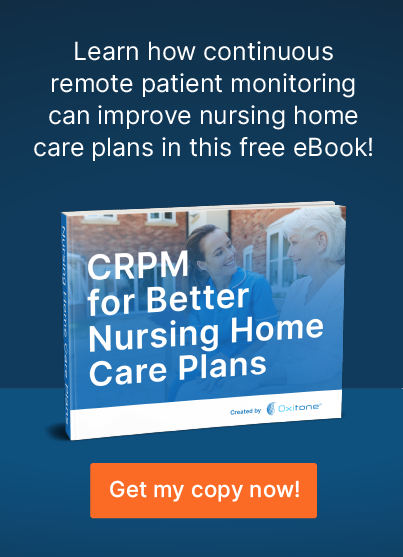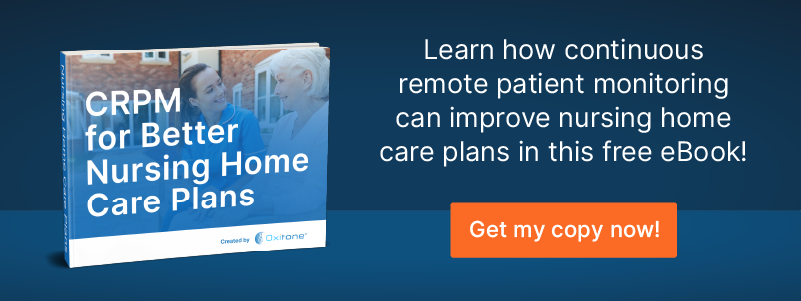Continuous remote patient monitoring (CRPM) systems are truly the future of healthcare. Continuous patient monitoring equipment offers real-time data for high-risk, medically-complex patients, while also eliminating the need for time-consuming and costly follow-up visits. Individuals with various medical needs can benefit from the use of continuous monitoring systems in their home, and so can nursing facilities, hospitals, acute rehab units, etc. Continuous monitoring systems are SaaS integrated and have a dashboard with comprehensive analytics that can easily be used as reporting for various disciplines. Remote continuous monitoring devices offer unparalleled convenience while reducing costs and giving patients peace of mind regarding their health status.
Continuous patient monitoring offers far more benefits than intermittent monitoring, as evidenced by several research studies. In particular, one study found that hospital patients hooked up to continuous monitoring systems were able to be diagnosed with and treated for sepsis faster than patients with the same condition who received intermittent monitoring. That is just one example of how continuous patient monitoring can benefit the quality-of-life and health outcomes of individuals with various, complex medical needs.
Patients
Continuous patient monitoring has been proven effective for the care of individuals with the following health concerns:
- Cardiopulmonary diseases
- Congestive heart failure
- Coronary artery disease
- Hypertension
- Valvular heart disease
- Obstructive sleep apnea
- Diabetes
- Markers of increased physiological stress
- Heart rate variability
- Sleep parameters
- Recovery from stress
If any of these conditions are unmanaged or steadily worsening, individuals are at a far greater risk for developing additional chronic or acute conditions. For this reason, continuous patient monitoring assists individuals in the prevention of health complications. Individuals who utilize patient monitoring equipment not only can keep their health parameters under control and manage chronic conditions, but they can also experience improved safety within the home.
The use of sophisticated technology allows blood oxygen levels to be taken on the wrist rather than an individual finger. This revolutionary feature makes it possible for patients to ambulate, reposition, transfer, and move around their environment with minimal limitations. Such a level of activity could not otherwise be achieved, since most CRPM devices require patients to remain seated and connected to a large, cumbersome device. The activity levels that wearable devices allow for assist with the prevention of health conditions that may arise from low activity levels, including pressure sores, deep vein thromboses, contractures, and muscle atrophy.
The simple, intuitive nature of continuous patient monitoring systems also makes them a great fit for individuals who are not good with technology or other assistive equipment. This removes the burden of device management from the patient, instead allowing care providers to remotely assist with the maintenance of their device as needed during the plan of care. Such ease of use offers patients enhanced quality of life, as they will feel reassured with the level of care that they are receiving. By allowing patients to have maximum control and autonomy over their health, the benefits of continuous monitoring systems also translate to the lives of caregivers.
Caregivers
Wearable continuous patient monitoring devices also serve to alleviate caregiver burden and give them improved peace of mind regarding the health of their loved one. Research shows that CRPM software is intuitive enough to allow for predictive care, beneficial insights, and heightened communication between caregivers, providers, and patients. An increase in the reciprocity of this relationship only benefits the care that patients receive, since caregivers can play a larger role in medical decision-making.
CRPM devices eliminate the need for caregivers to track, organize, and interpret vital signs, health statistics, and other health-related data in preparation for follow-up visits. By removing this tedious part of a caregiver’s job, patient monitoring equipment allows caregivers to engage in more authentic interactions and provide more person-centered care for their loved ones. As a result, caregivers will no longer be required to provide direct, 24/7 supervision. They will also notice decreased feelings of worry and less burden of care.
Managing appointments can be another time-consuming and anxiety-provoking part of a caregiver’s job. The remote nature of CRPM devices makes for fewer follow-up appointments to review and discuss health data, as such duties can now be completed virtually through the state-of-the-art monitoring systems. By reducing the number of complex care-related tasks that are part of a caregiver’s responsibilities, CRPM devices can greatly improve a caregiver’s ability to effectively oversee the health of their loved one.
Physicians
As you can imagine, the numerous benefits of wearable CRPM equipment also extend to the professional lives of healthcare providers. Providers across all practice settings can incorporate statistical data from CRPM devices into the treatment plans of their patients. These include registered nurses, licensed practical nurses, physicians, occupational therapists, physical therapists, speech therapists, respiratory therapists, and other allied health professionals.
Patient monitoring systems give providers real-time information to inform their clinical decisions, therefore enhancing health outcomes for all. The non-stop nature of continuous patient monitoring devices also eliminates any gaps in health data. This is incredibly beneficial, as gaps make it more difficult for providers to gain an accurate picture of patient needs and therefore, make appropriate aftercare plans or home recommendations. Health data is similarly crucial for prescribers, or healthcare clinicians who administer and monitor medications to patients. Prescribers must verify medication effectiveness (or lack thereof) in order to know whether it is alleviating symptoms, making them worse, causing dangerous drug interactions, or having no effect at all. This informs their ability to modify dosages, discontinue certain drugs, or add new medications as needed.
Monitoring patients remotely is especially helpful for patients with infectious diseases, such as MRSA and VRE, and airborne infections, such as COVID-19. These monitoring systems allow clinicians to minimize patient contact, while still effectively carrying out treatment plans to vitally manage chronic health concerns. Additionally, a decrease in the amount of contact time leads to enhanced provider efficiency and an overall increase in productivity, which is an essential aspect of clinical care due to payer guidelines.
Medical Systems
Since continuous monitoring systems have a large impact on many parties within hospitals and nursing facilities, it may come as no surprise that there are also ample benefits to medical systems themselves. One of the main aims of hospitals and institutional facilities is to keep their patients safe and get them healthier in as little time as possible.
Continuous monitoring systems play a large part in accelerating patient recovery time, primarily by reducing the risk of complications that may result from gaps in continuity of care. Additional CRPM benefits that prevent new health concerns from arising include increased patient mobility and a preserved ability to functionally care for themselves.
Since patients who use CRPM devices can maintain their ability to ambulate while in the hospital, this also lowers their risk of falling and developing additional injuries. Simultaneously, a maintenance of function has been proven to shorten hospital visits and prevent hospital readmissions that may occur due to complications. This is a major benefit to large health systems, as this allows hospitals to free up beds more quickly, therefore lowering costs and decreasing the overall utilization of resources. It also helps reduce and optimize workloads.
Wearable devices prevent the need for patients to don excess wires, lines, and tubes, which are already an intimidating part of hospitalization. This certainly plays a large role in enhancing patient quality of life and reducing the negative emotional response to both temporary and chronic illness, injury, and disability.
In summary, CRPM and other patient monitoring equipment enhance the continuum of care, improve health outcomes, lower caregiver burden, and increase health-related quality of life. Wearable CRPM enhances functional performance and engagement within an individual’s chosen environments and allows patients to smoothly move from the hospital and a skilled nursing facility to their home with ease. This ongoing transition allows individuals to maintain a high level of autonomy over their health while managing current health issues and preventing future complications from evolving. Patient monitoring systems offer state-of-the-art technology that strongly aids in all aspects of treatment for a variety of complex medical concerns.
Here at Oxitone, we boost value-based healthcare by delivering extraordinary patient, clinical, and economical outcomes at reduced medical utilization and cost. Patients need a prompt response to emergencies. Physicians need an easy and timely follow-up with patients. Our mission is to transform chronic disease management and help save lives worldwide.
Let’s save lives together! To see how we help remote patient monitoring companies and physicians improve the management and care of high-risk patients, contact us today!


